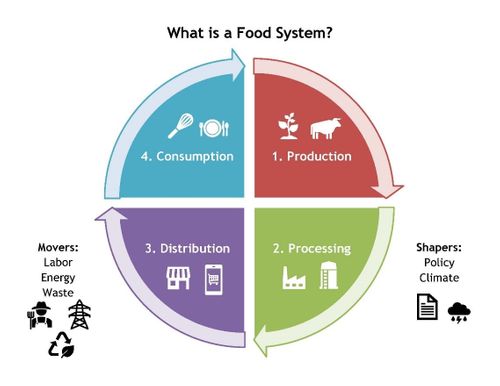Food is one of the foundations of life. Every species on earth depends on it for survival no matter what form it takes. Sunlight, Meat, Vegetation, etc. the only bias it holds is who can attain it. So, what makes us humans special? Agriculture. We’ve developed a unique technique of cultivating our food across the globe and ship it to urban hubs so metropolises and food deserts of the world can be sustained. This supply chain, now critical to human development, comes at a hefty cost to our environment. This cost can be described as food miles and changes drastically depending on where you live and the current season. Below I will discuss examples of pressing issues within the Food System, how it affects our community, and what we can do to alleviate this cost.

What is the problem?
Since we’re talking about food and the transportation of it you’d think it would be a relatively simple matter right? Well, let’s jump back in time to 1996 and the publication of “The Food Miles Report” by Angela Paxton. In this report she coins the term “food miles” as the main focus of her UK study. She defines food miles as the distance food travels in its supply chain pattern from farms all the way to households. Her main points from the report are that food travels THOUSANDS of miles from its growing source, and the types of crops we demand are no longer seasonal (further increasing unnecessary transport distances and increasing CO2 emissions). “In the UK, comparatively little of the food we consume comes from local producers; and much will have been transported over great distances – such as apples 14,000 miles from the New Zealand, and green beans 4,000 miles from Kenya.” (Paxton 1994).

While this study was done in the UK, it still applies to the US food system as well. Think about your own habits. What are you eating during the fall and winter Fruits? Fresh Veggies? These crops have been transported from warm tropical regions where they can be grown year around; however, the issue is that it encourages consumers to eat seasonally no longer. This means during the winter months this fresh produce is travelling further and further away, contributing to carbon emissions all the while.
Our Community
North Carolina is a huge exporter of agricultural goods, but agriculture doesn’t always mean food. The biggest cash crops in North Carolina today are corn, tobacco, soybeans, and cotton. Sure, we can eat corn and soybeans, but roughly 70% of all soybeans produced go into animal feed along with 44% of corn (Schnitkey et al. 2021).
This all sounds great economically, and it is. North Carolina is ranked 9th amongst the states in terms of agricultural export value (NC Department of Agriculture 2023), but this comes at a cost. Because we are exporting so much of our crops, and the crops we grow to begin with are not used as a food source, this has inadvertently exacerbated food deserts across the state.
Food Deserts
According to the 2008 Farm Bill, food deserts can be described as “neighborhoods that have limited access to affordable and nutritious food and tend to be composed of low-income consumers.”

The FDA has recognized 349 food deserts in North Carolina, and a majority of them reside in rural areas where agricultural income is present. These rural areas have low population densities but high rates of crop yield. Low population density means that grocery stores become less frequent if even present while the majority of crops grown are cash crops, contributing no source of nutritious food to these areas. This relationship is incentivized by the higher profit margins of cash crops where the produce is shipped out rather than sold locally.
Food deserts are a complex issue with many other factors such as competition from corporations like Dollar General, low income, and slim profit margins from grocery stores in general. The combination of all these factors including the current NC food system have caused North Carolina to be ranked 5th nationally in food insecurity (Center for Heath Law and Policy Innovation).
Sustainable Solutions
There are a multitude of solutions that can begin to reduce the effect that the Food System has on North Carolinians.
Individuals
On an individual level, those looking to reduce their own impact starts with their diet. Seasonal diets used to be a necessity but have been lost to time and technology. What we thrived on during the winter months is no longer necessary when you can grow and ship any kind of produce in consistent warm climates. The ability to do this has massively increased general quality of life and expanded the pallets of millions but has come at a cost of environmental degradation.

Think about that burger you ate last year in the middle of winter. Did it have a tomato on it? Lettuce? In all likelihood those travelled thousands of miles from a place where you can grow a tomato in January. It might seem like a small thing, but if whole communities make diet adjustments, it can heavily reduce CO2 generated from the food system.
Another great easy way to do your part is to start growing your own produce. Having a few fruiting plants during growing seasons are a great way to reduce your own food miles because you can’t get closer than your own backyard! I would encourage everyone to try it out as a fun hobby. The produce grown is considerably more nutritious and better tasting than anything you could get at a grocery store! If you don’t know where to start there is a great urban farmer who has a YouTube channel (@SpicyMoustache) that has great tips and tricks for setting up your own personal farm.

Business’s
Businesses also have their role to play. Grocery chains have farmers across the country that they exclusively do business with and allow them to ship their product across the country. While these kinds of decisions are made by upper management of the corporations, priority should be given to locally sourced or fair-trade produce when possible.
Along with this, retailers should also begin to include labeling schemes. Angela Paxton recommended in her report that retailers should begin a labeling scheme that includes the distance produce travelled to the grocery store. This is a lovely idea; however, without any incentives or policy changes this one is unlikely to occur, which leads us into the government’s role.

Governmental
The most effective and worthwhile avenue to change the food system is governmental assistance. American Agriculture is a lucrative industry, in 2021 it contributed roughly $1.264 trillion to United States gross domestic product (USDA 2021). The industry’s downfall is that the farmers actually creating the product see very little return and show razor thin profit margins.
Governmental funds could be allocated exclusively for subsidies regarding crop choice by farmers. Corn and soybeans are king financially, so without any financial incentives farmers understandably choose to grow corn rather than collards or potatoes. This change (while costly) could increase the amount of local food present statewide, allow rural communities to establish farmers markets, and create better financial situations for struggling farmers. Currently today’s subsidies are exclusive to corn, soybeans, cotton, wheat, and rice (USDA). There are no subsidies for fruit and vegetable growers.
Some “Food” for Thought
Growing up in the Raleigh area I had no idea how privileged I was when it came to locally sourced food. The Farmers Market off of Lake Wheeler is one of the biggest and broadest markets in North Carolina and in the past I hadn’t utilized it enough myself. I came to that realization and started going religiously. Even though it’s less convenient for me to go there instead of the grocery store down the street, I have grown to love it and it has become something that I look forward to on a weekly basis. It’s such a small thing, and on an individual level it doesn’t contribute much to the overall carbon footprint, but it is something that I can control. That aspect alone makes it worth it.
Researching the food system made me realize that so much of our mental health revolves around control. Constant ecological issues and a looming threat of climate catastrophe gets overwhelming if that’s what you focus on. How can you fix something that’s bigger than any individual?
Little changes in behavior like going to the farmers market, like doing your own gardening don’t make a change in the grand scheme of things. They make a change in your life. These things are what you can control, these little changes in behavior do affect your life. So, isn’t that enough? I certainly think so.
The Food System is a complicated, robust process that can’t be fixed overnight, but it can be fixed. From policy changes to fair trade products, shopping locally, change is possible! We just have to take the steps forward, and that falls on personal accountability. Everyone starts somewhere, and that’s ok, but it’s time to take the first step, no matter how big it is. Anywho, thank you for going on this journey with me and reading this lil ‘ole environmental blog. Even if i’m not telling you to, always keep it clean and leave it better than you found it.

– Chase
Leave a comment